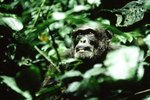
The tree-loving koala (Phascolarctos cinereus), an inhabitant of Australia, may look like a little teddy bear but is a actually a marsupial, kin to the opossum and the kangaroo. These family Phascolarctidae members are notable partly for their very thick, fuzzy fur, which is generally brownish or gray in coloration. The average weight for a koala is approximately 20 pounds, "National Geographic" says.
Koala Population
Koalas are known the world over as a symbols of Australia. Koalas' status is of "least concern" according to the IUCN Red List of Threatened Species' 2008 appraisal. Although the exact population of koalas living throughout Australia is uncertain, they are generally believed to have strong and consistent numbers. The guesses for the koala population have a wide range, from as low as 43,000 to as high as hundreds of thousands, according to BBC News in 2012.
Geography
Koalas are originally from the eastern region of Australia -- think Victoria, New South Wales, Queensland -- and some parts of the South Australia state, which has a central location. They were brought to western regions of Australia and also to islands such as Magnetic Island, French Island and Phillip Island.
Natural Habitats
Koalas like to live in scrubland eucalyptus forest, according to the San Diego Zoo website's Animal Bytes feature. They generally opt for woodland and forest environments full of trees -- particularly eucalyptus ones. Although eucalyptus trees are certainly their dietary preference, they also occasionally feed on Angophora, Corymbia and Lophostemon trees as well. If a specific setting hosts any of these types of trees, a koala will probably be able to manage there just fine. Since eucalyptus makes up the bulk of the koala diet, the availability of it largely determines whether or not a specific setting is suitable for sustaining koalas.
Koala Risks and Problems
Ruination of habitat is a risk for koala populations. Factors that contribute to the loss of koala habitat include bushfires, urban development, deforestation and agricultural expansion. With growing urban development, deforestation and similar problems, increasing numbers of koalas now have no choice but to live in suburban and urban locales -- typically in gardens of homes, on school playgrounds or in public parks. Outside of just habitat issues, disease and drought also negatively affect numbers of koalas. Due to overly high populations, koalas are considered to be pests in certain parts of Australia -- Kangaroo Island being one specific example. On the island, koalas' excessive browsing activities are linked with the demise of many eucalyptus trees.
References
- San Francisco Zoo: Koala
- San Diego Zoo's Animal Bytes: Koala
- National Geographic: Koala
- University of Michigan Animal Diversity Web: Phascolarctos cinereus
- IUCN Red List: Phascolarctos cinereus
- WAZA: Koala
- ARKive: Koala
- BBC News: Australia Lists the Koala as "Vulnerable" Species
- South Australia Department of Environment, Water and Natural Resources: Kangaroo Island Koala Management Program
- Koala Central: Urban Koalas
Photo Credits
-
Ablestock.com/AbleStock.com/Getty Images



